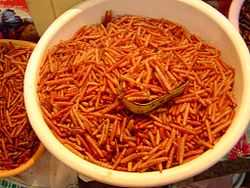Comadia redtenbacheri
| Comadia redtenbacheri | |
|---|---|
| Scientific classification | |
| Kingdom: | Animalia |
| Phylum: | Arthropoda |
| Class: | Insecta |
| Order: | Lepidoptera |
| Family: | Cossidae |
| Genus: | Comadia |
| Species: | C. redtenbacheri |
| Binomial name | |
| Comadia redtenbacheri (Hammerschmidt, 1848) | |
| Synonyms | |
| |
Comadia redtenbacheri is a moth in the Cossidae family. It is found in North America, where it has been recorded from Mexico and southern Texas.[1]
The length of the forewings is 12–14 mm for males and 13–16 mm for females. The forewings are brown with a white strip from the wing base to near the apex. The hindwings are grey-brown.[2] Adults have been recorded on wing from April to May and in September.[3]
The larvae feed on the succulent leaves of the maguey and Agavis salmiana. Young larvae are pale reddish, becoming carmine in later instars.
In food and drink
The larvae are one of the species used to put into mezcal.[4] In Spanish, they are known as chilocuil, chinicuil, or tecol and have been traditionally used as food in Mexican cuisine. The caterpillars are also known as gusanos rojos, giving its name to a popular brand of mezcal; they are one of the two kinds of "worms" placed in bottles of mezcal, giving a unique color and flavor to the drink. The other, less appreciated ones, are the larvae of the agave snout weevil, Scyphophorus acupunctatus.
-

A dish of chinicuiles (roasted larvae of Hypopta agavis) in a market in Tula, Hidalgo, México
See also
- Acentrocneme hesperiaris
References
- ↑ Comadia at funet
- ↑ Brown, R.M., 1975: A revision the North American Comadia (Cossidae). The Journal of Research on the Lepidoptera, 14 (4): 180–212. Full article:
- ↑ mothphotographersgroup
- ↑ Bug Guide